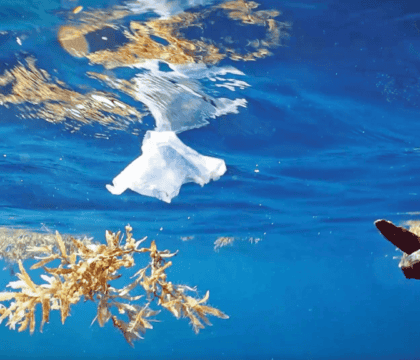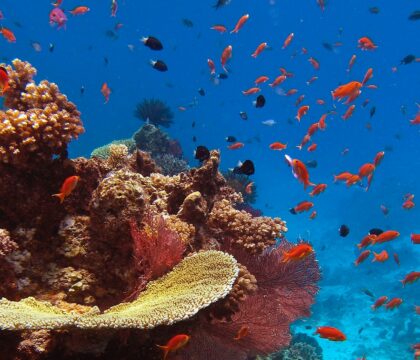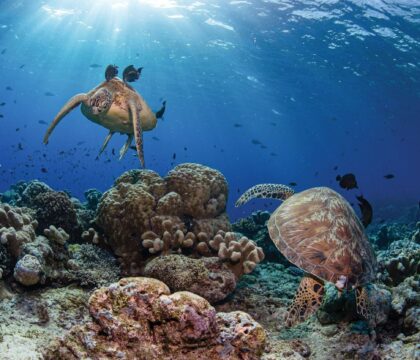November 1, 2022 • Travel Ideas
Palau’s Jellyfish Lake (known in Palauan as Ongeim’l Tketau) is a saltwater lake on Mecherchar (Eil Malk) Island within Palau’s Rock Islands that is known worldwide for its profusion of bright orange, harmless, and beautiful jellyfish. Named for its inhabitants, Jellyfish Lake is a UNESCO World Heritage Site and one of the best places in the world to enjoy the otherworldly experience of swimming amongst a sea of frilly jellyfish.
“Fluorescent green, the lake is home to millions of jellyfish that do not sting. They were pulsating orange blobs, and ranged in size from Ping-Pong balls to bowling balls.”
– Ian Urbina, The Outlaw Ocean, on Palau’s famous Jellyfish Lake.

Oceanic Society board member, Dr. Sylvia Earle, snorkels in Palau’s jellyfish lake during a joint expedition by Oceanic Society and Mission Blue. © Kip Evans / Mission Blue
The Golden Jellyfish of Palau’s Jellyfish Lake
There are seventy marine lakes within the Palau archipelago, and only five that contain jellyfish. Of these five, Jellyfish Lake is the only one that is open to visitors, and it is here that you can have the unforgettable experience of swimming among a sea of harmless jellyfish. The most abundant jellyfish in Jellyfish Lake is the golden jellyfish, Mastigias papua etpisoni, a subspecies found nowhere else. The population of golden jellyfish in Jellyfish Lake fluctuates, primarily due to weather conditions, at one time reaching more than 30+ million jellyfish in the lake (2005), and at other times falling so low that the lake had to be closed to visitors for two years (2016-2018). According to the Coral Reef Research Foundation, there are typically around 5 million golden jellyfish in Jellyfish Lake.

Palau’s Jellyfish Lake is home to a unique subspecies of golden jellyfish, Mastigias papua etpisoni. According to the Coral Reef Research Foundation, there are typically around 5 million golden jellyfish in Jellyfish Lake. © Wayne Sentman
One unique feature of the golden jellyfish in Jellyfish Lake is their daily migration across the lake following the sun. As the sun rises in the east, the jellyfish swim towards the sun, staying out of the shadow cast by the surrounding hills. Throughout the day, they then follow the sun across the lake to the west, always staying in the sunlit areas of the lake. On sunny days in particular, this results in large concentrations of jellyfish in certain parts of the lake. The reason for the migration has to do with the symbiotic algae that reside within the tissues of the jellyfish (zooxanthellae, like those found in corals). Those algae require sunlight for photosynthesis, which they use to make energy and in turn provide food for the jellyfish. The jellies’ movement to follow the sun therefore maximizes the photosynthesizing potential of the algae, benefiting both algae and jellyfish.

An aerial view of Palau’s Jellyfish Lake. The jellyfish spend the day slowly making their way from one end of the lake to the other, following the path of the sun. The sunlight supports algae growth, food for the colorful jellies. © Flickr user LuxTonnerre [CC BY 2.0]
Protection of Jellyfish Lake
Palau has taken strides to ensure the protection and longevity of the jellyfish and the unique experience of swimming with them. For example, scuba diving is prohibited in Jellyfish Lake in order to prevent mixing the two stratified layers within the lake. The top layer is less saline, which makes it ideal for the jellyfish and other wildlife, like fish and plankton. The lower layer, on the other hand, contains dangerous levels of hydrogen sulfide, which can be toxic to both humans and wildlife.
Beyond the ban on scuba diving, visitors to Jellyfish Lake can wear only reef safe sunscreen that has been applied at least 30 minutes before entering the water. Visitors are also encouraged to sign the Palau pledge, a promise to protect and preserve Palau’s natural beauty, cultural heritage, and environment. Finally, the jellyfish population is closely monitored, and the lake has been closed in the past when jellyfish populations fall too low.
Swimming in Jellyfish Lake

A once in a lifetime experience, swimming in Palau’s Jellyfish Lake should be on any nature lover’s bucket list. The unique experience is one of many on our Palau: Snorkeling the Rock Islands trips, with dates available multiple times throughout the year. Don’t miss your chance to swim with these remarkable and endearing jellies!




